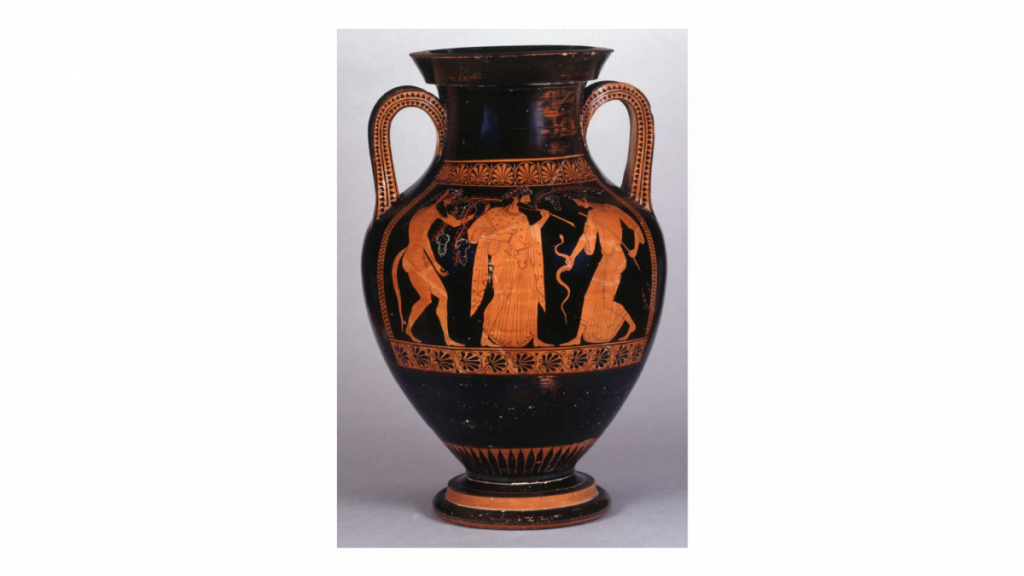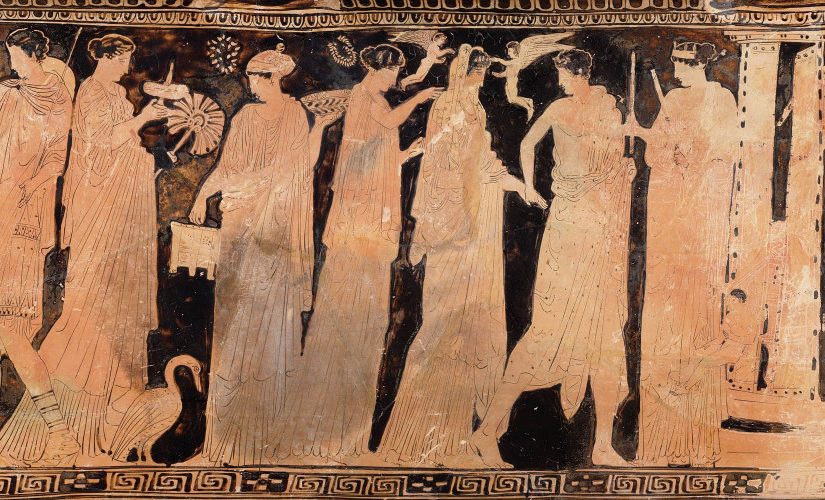The end goal of my textile work and research this year is to create a chiton. Anyone who has looked at a number of ancient Greek vase paintings and sculptures has probably seen a chiton, though it can be easily confused with another ancient Greek garment, the peplos. In this post, I’ll talk a bit about what a chiton looks like, its origins, and many of its attributes.
A chiton (plural chitones) is a type of linen tunic that was usually floor length, diaphanous, and sleeved. It was made by taking either one or two pieces of fabric and sewing up the sides, creating a tube, which a person then could slip over their head. Sleeves were created by attaching buttons along the top edge of the garment or by sewing . Brooches may also have been used . A chiton was belted with a zone, which loosely means “belt”, but could also mean, “girdle”. A zone was more or less a narrow piece of cloth, leather, or cord . Chitones are classified as endumata, literally, “undergarments”; what this actually means is that endumata are garments worn next to the skin . A person would not have worn a chiton alone and would have donned some sort of over-garment – epiblemata – as well .

The chiton was likely not a garment native to Greece but was adopted from the East during the Bronze Age . One of the pieces of evidence that support this is the word chiton itself. The word chiton is attested to in Linear B tablets, “ki-to“, which may linguistically be linked to the Akkadian word kitinnu-, “linen garment” . In his Histories, Herodotus labels the chiton as Ionian (from the central coast of western Anatolia) but was originally from Caria (also western Anatolia, but east of Ionia). Visually, the Greek god Dionysos, who is often framed as a foreign deity from the East (though he is not), is often shown on vase paintings wearing a chiton, further signifying the chiton’s associations outside of ancient Greece . Before the introduction of the chiton, women would have worn the peplos, or the Dorian chiton as Herodotus calls the garment. A peplos is a rectangular piece of cloth usually of made of wool that is draped around the body and fastened at the shoulders with pins and later buttons. It is girdled or belted like the chiton. The peplos typically doesn’t have sleeves but does have an over-fold of fabric that “cuts” the body in half visually called the apoptygma .

The chiton was worn by both men and women, though not consistently. It was worn exclusively by men in Homer’s time, but was rejected by the men of Athens for more “moderate clothes” by the 5th century BCE according to Thucydides’ Histories . This seems to be supported by visual evidence (vase paintings and sculpture) in that male figures before the middle of the 6th century BCE are often shown wearing a chiton, but later in the century only older men, priests, and mythological and historical figures (especially of Eastern origin) are depicted wearing the garment . Athenian women started to wear the chiton at the beginning of the Archaic period, usually with a himation, which is a large and rectangular piece of cloth wrapped around the body and draped across the shoulders . And, while chitones may have stopped being worn by most men by the Classical period, women seemed to have continued to wear them well into the Classical period; the pins that are necessary for wearing a peplos became nearly absent in the archaeological record when the chiton became popular among Athenian men, and continued to remain absent even after the men of Athens adopted other garments. This suggests that women must have continued to wear the chiton (.
As mentioned above, the chiton was typically made from linen. Linen is made from flax and tends to make a fabric that can easily be pleated. The fact that linen can hold small, tight folds is helpful in identifying chitones in visual evidence . A chiton wasn’t always necessarily made of linen, though. There are times in sculpture when a figure is wearing what appears to be a chiton, but the folds are broad and flat, suggesting a woolen fabric instead of linen; an example of this can be seen in the Phrasikleia kore (maiden) . Along with form, the preserved polychromy of ancient sculpture also suggests the use of something other than linen for the chiton. Linen is notoriously difficult to dye, and two sculptures – the Phrasikleia kore and the Chiot kore of the Acropolis – are shown to be wearing a red chiton and blue chiton, respectively .

The Phrasikleia kore. 
The Chiot kore.
There are several variations on the standard chiton. The chitoniskos was developed in the middle of the 6th century BCE during development of military attire. Its length extended only to the upper thigh and it had shorter sleeves. While it may have had a military origin, the chitoniskos was also associated with unmarried women. Female dancers and athletes wore chitoniskoi and parthenoi (young unmarried girls) wore them during initiatory rites. Artemis, the virgin goddess of the hunt and protector of girls, is usually portrayed wearing a chitoniskos . Another variant is the exomis, which is worn over only one shoulder, usually the left, and was often seen on craftsmen and warriors . The exomis can many times be seen worn by Hermes in art and is sometimes known as a chiton heteromaschalos . There are many terms to denote the many little variations one can find in a chiton: a chiton that is so long that it falls in folds over the feet – a true mark of luxury and elegance – is called a chiton poderes. If the chiton had a fringe decoration then it is a chiton termioeis. A chitonion specifically points to a women’s garment that would have been semi-transparent, costly, and alluring .
The chiton, as you can see, is a garment that is quite simple in structure and yet not simple at all in its significance. It is not originally of ancient Greece, but the chiton, along with the peplos, is what people think of when imagining the clothing people wore in that day and age. Worn by both men and women, the chiton was versatile with many variations, and yet very much associated with femininity and Eastern luxury .
Works Cited
